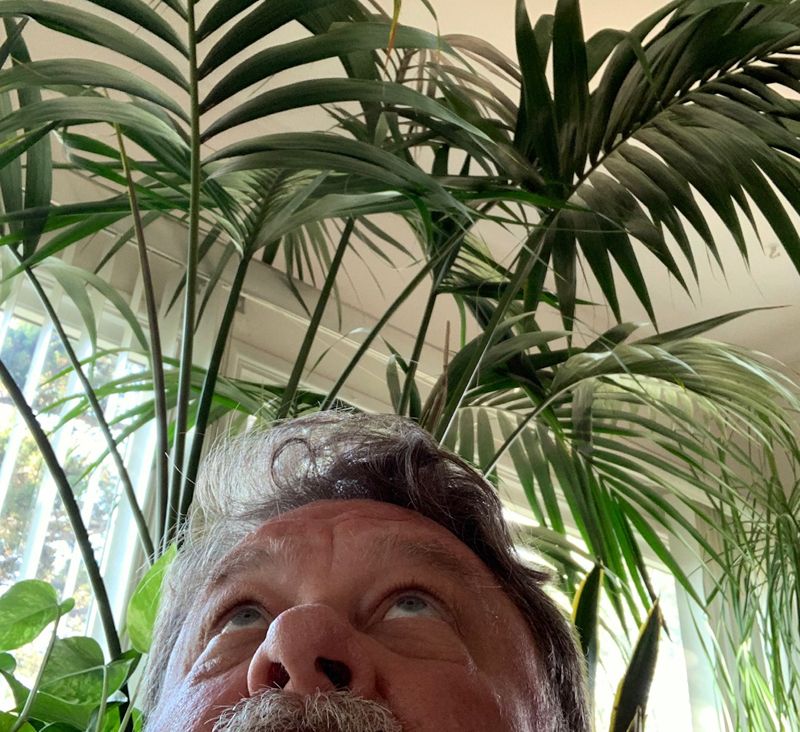
Have you ever met a plant stylist? You have if you have ever met me! Sitting at home with a few of my own indoor palm trees.
Have you ever met a plant stylist?
Good Earth Plant Company and other businesses like ours have helped bring nature into our clients’ environments with plants and the principles of biophilic design for many years through professional plant care for offices and homes. The term in our industry for decades has been “plantscaping,” but it can be a little hard to explain sometimes.
Finally, I think we’ve found the right way to describe what we do: Plant Stylist! It’s getting attention thanks to this article in the New York Times last week.
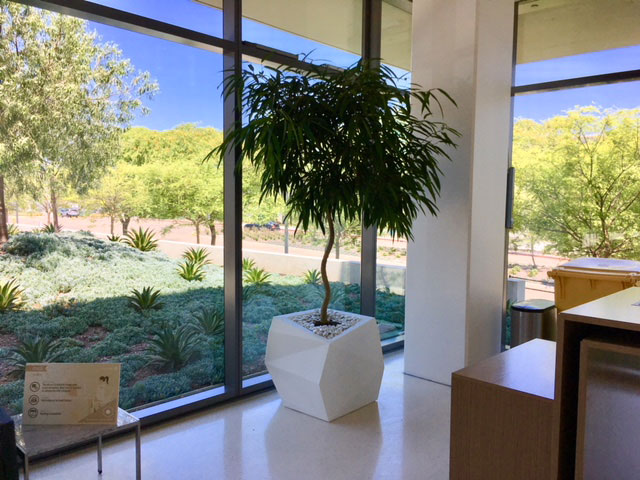
An indoor tree in one of our favorite “origami” style containers for a Plantscaping client.
Lots of people get addicted to indoor plants with small, easy to grow desktop choices. There’s not much risk or investment if you lose a small plant during the learning process.
Eventually, you might want to do something more ambitious. But how do you know whether you’re choosing the right plant for the conditions? When you start making bigger investments in your plants, it’s a good idea to get some advice. Good Earth Plant Company is here to be your Plant Stylist!
Now you can get a residential consultation about your plants for a lot less than the folks in New York .. We are scheduling appointments with our experts to help assess and guide you on the best plant choices and ongoing care. We can even arrange to bring you the plants and planters you want! Click to our “Contact Us” page to get in touch.
One of the items we can help with is adding an indoor tree to your home décor.
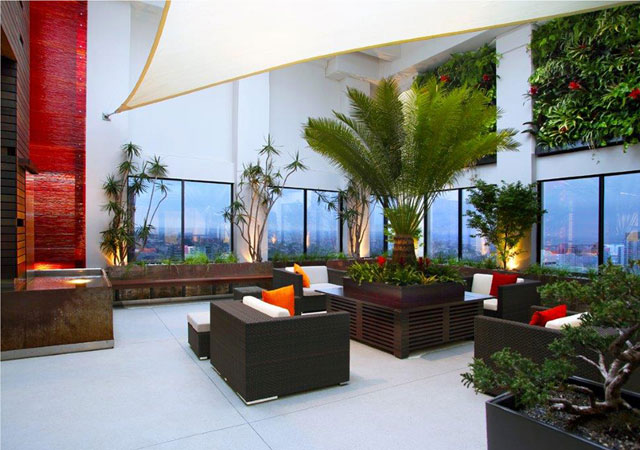
We used a large palm tree in this interior plantscaping design.
Indoor trees can add an impressive accent and focal point to your indoor space. Dress up a boring empty corner, or accent your entry hall or lobby. Put a fresh burst of greenery in a bedroom or guest room. One of my favorite things is to use an up-light to cast a shadow of the leaves on the ceiling. Remember: Up-lights don’t help a plant grow – they just look cool. Bonus: indoor trees can help clean the air in your home or workplace.
At Good Earth Plant Company, we are big fans of using indoor trees in Plantscaping and Plant Styling for our clients.
It isn’t hard to keep an indoor tree healthy. Many are surprisingly easy to grow. But you DO have to select the right type of tree for the right spot in your house, obtain it from a quality nursery, and know how often to water and feed it. It’s upsetting and demoralizing to see your indoor tree drop leaves and slowly die right before your eyes.
When choosing a tree, you’ll need to know:
- How much light it will get
- How much space you have to work with
- How big the tree will grow
- How finicky it is about water, drafts or temperatures
- For those with children or pets, whether your choice is non-toxic
Once you know what conditions you have to work with, you can choose the right tree whose growing requirements match up to your space. There are lots of great choices – and some aren’t actually trees, but large plants that grow well indoors.
Here are some of Good Earth Plant Company’s favorites:
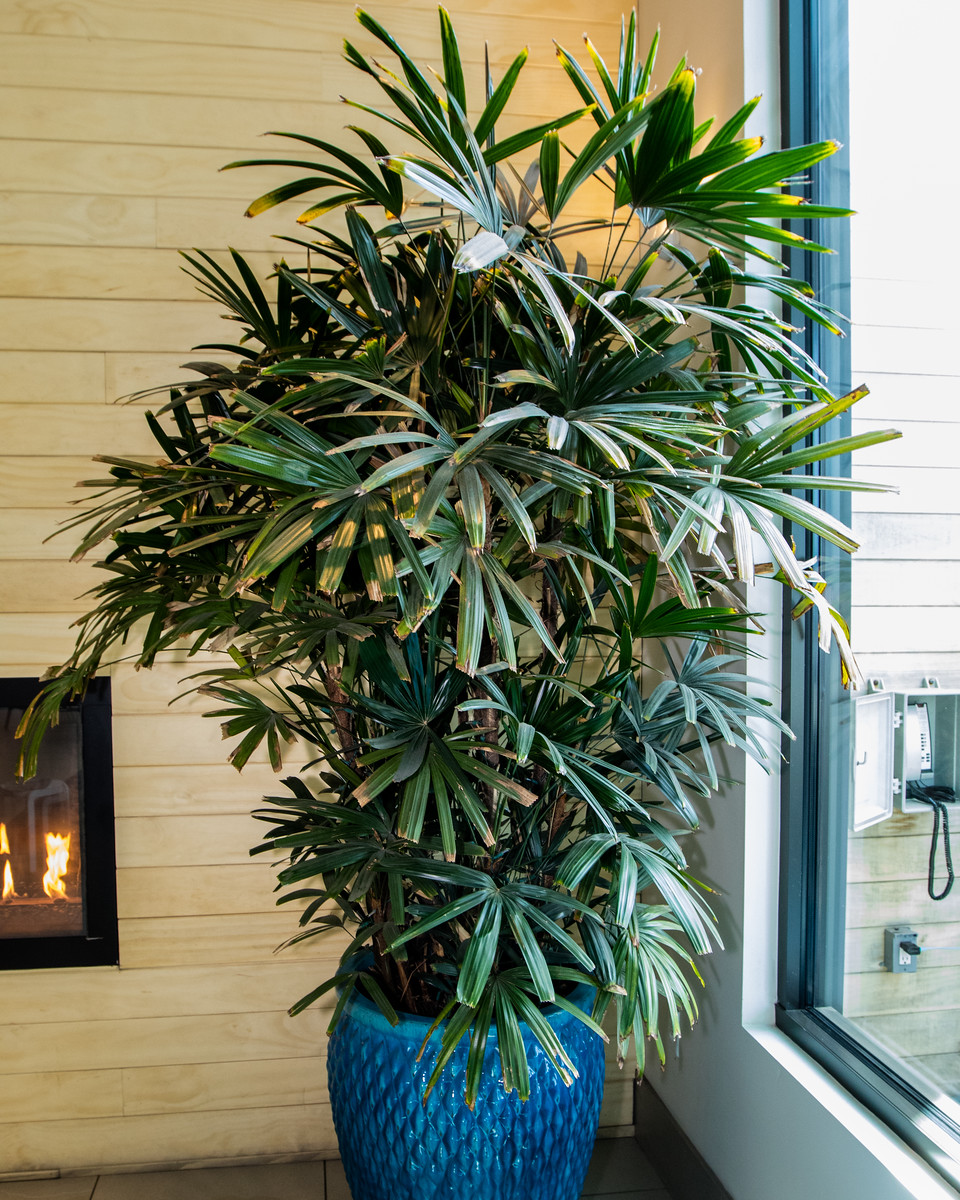
Good Earth Plant Company ensures your trees are fresh and healthy, placed in containers inspected for quality, and in the proper growing conditions.
- The ficus family consists of trees native to the tropics, but often used as houseplants. The reason they do well inside is that the floor of the jungle is heavily shaded by the dense leaf canopy above.
- Fiddle-leaf fig. This ficus is the celebrity tree star of interior design right now. It is a type of ficus with large, dramatic, violin-shaped leaves. It will fill up an empty corner and liven up any room. Fiddle-leaf figs like bright, indirect light, and moderate watering. When maintained as an indoor house plant, they are five to eight feet tall. But they CAN grow up to 50 feet tall outdoors.
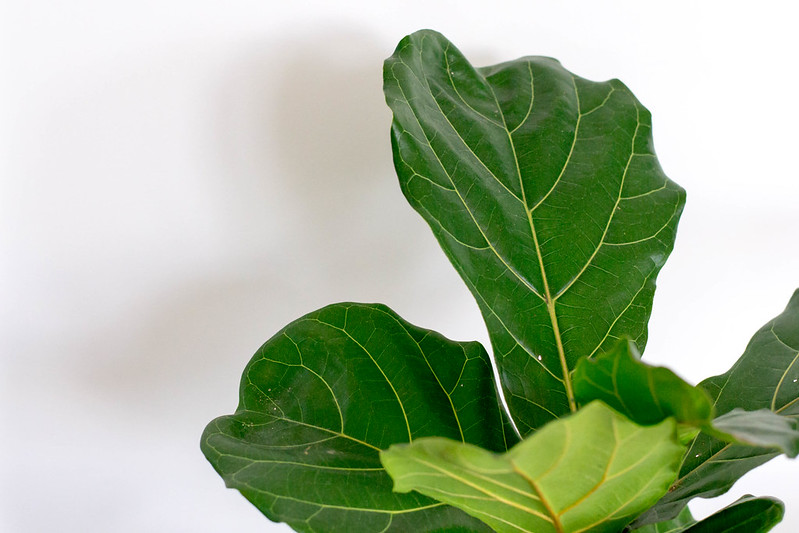
Fiddle Leaf Figs are prized for their large leather-like leaves. Photo: Lisa Taliana/Pixabay Creative Commons
- Rubber plant. These pest-resistant ficus trees with leathery-leaves are native to Southeast Asia. Grow your rubber plant in bright light, but avoid direct sun or drafts. You can repot it yearly until it reaches the height you want. Then you can keep it in your favorite container, and replace a few inches of soil on top of the plant every year with fresh potting soil. Just take care not to damage surface roots.
- Leafy weeping figs, also known by their Latin name of Ficus Benjamina. Ficus Nitida is a close relative. Weeping figs are popular for their graceful appearance and glossy leaves. They are also popular because they will tolerate limited indoor light. They are normally pruned to stay between five and eight feet tall. But if you have a large space, they can grow much, much taller and wider – the size of a city block! A real bonus: Weeping fig is one of the best plants for improving air quality indoors. It has one of the top removal rates for air toxins, such as formaldehyde, benzene, and trichloroethylene.
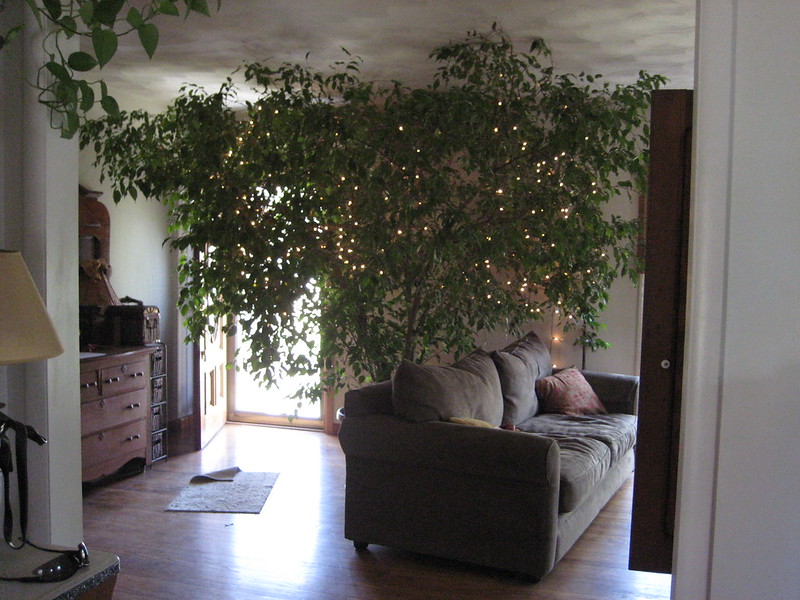
This Ficus is the centerpiece of a living room. It is 20 years old! Photo: Madaise / Pixabay Creative Commons
- The Dracaena family: Corn plants, dragon trees or Dracaena Fragrans, have been popular for 100 years in the United States. Corn plants grow tall and narrow and grow slowly. They can take a fair amount of abuse. They will tolerate low light, but they will grow faster with a little filtered sunlight. They do like humidity, so they’re ideal for a bathroom or kitchen.
- Indoor palms. There are many varieties of palm trees, and they are the most common large houseplants. Many grow well in part-sun or indirect sun, and they can tolerate a lack of water. Spider mites tend to gravitate to indoor palms, so keep the tops and bottoms of the leaves clean. Palms have different types of leaves and shapes. Some of the most common indoor choices are Kentia palms, Areca palms, Bamboo Palms, Fishtail palms, and pygmy date palms.
- Yucca is a tough plant that can be grown both indoors and outdoors. It quickly becomes large if sufficient light is provided. When growing Yucca indoors, provide as much sun as possible and do not overwater. Allow the soil to dry out before you water again. It can survive easily for several weeks without water.
- Tree Philodendrons are easy to grow and can fill out a large empty space. They don’t need a lot of water and thrive in indirect sunlight. The huge leaves can be two feet across and grab your attention. BUT a word of caution: Philodendrons are toxic to pets who may like to dig or chew, so avoid them if you have a dog or cat.
- Umbrella tree or Schefflera is a tall, common houseplant that can be grown as a tree. They are easy to maintain in the right conditions, which are bright, indirect sunlight and a fairly large container. Many types have pretty, variegated leaves.
- We see giant birds of paradise (also known as white bird of paradise) plants all over Southern California. But you can grow it indoors too if you have a spot that gets at least four to five hours of daily sunlight. The giant variety grows eighteen feet tall, so choose your location carefully.
The greatest challenge to keeping indoor trees happy and healthy is the same problem many other plants have: too much water. Soggy soil will kill just about any tree. So please resist the temptation to water your trees too often, thinking they need a lot of water due to their size. Instead, let the soil dry out completely on top. Indoor trees shouldn’t be watered more than once a week – and sometimes less. Less really is more here.
When you do water, soak those tree roots well.
Don’t over-fertilize your trees. Once or twice a year is plenty. If they are happy in their location and conditions and show nice growth, they are doing fine.
You may need to prune your indoor trees. It’s good for the trees and keeps them in shape. Don’t let your indoor tree grow until it looks messy and needs drastic pruning. It’s a shock to the tree and could kill it. Use regular pruning shears or even sharp kitchen scissors.
Keep your tree looking its best by making sure to dust the leaves. Wipe them both on the top and the bottom gently with a damp cloth a few times a month.
If you’d like some professional help with your indoor trees or plants, we’re always ready for you at Good Earth Plant Company. Get in touch with us for a consultation at 858-576-9300, or email info@goodearthplants.com
We enrich people’s lives with plants. Would you like a one-time residential consultation about your plants? Good Earth Plant Company is now offering a brand new service for your home – a visit from one of our “Plant Stylists.” We are scheduling appointments with our expert plant technicians to help assess and guide you on the best plant choices and ongoing care.

